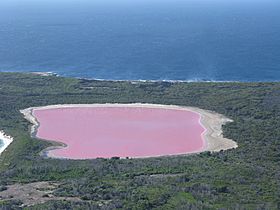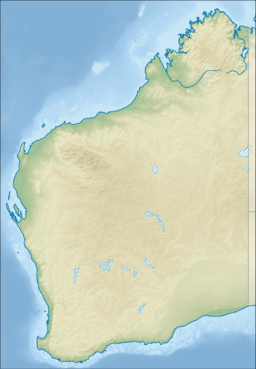Lake Hillier facts for kids
Quick facts for kids Lake Hillier |
|
|---|---|
 |
|
| Location | Goldfields-Esperance, Western Australia |
| Coordinates | 34°05′45″S 123°12′10″E / 34.09583°S 123.20278°E |
| Type | Salt lake |
| Basin countries | Australia |
| Designation | Recherche Archipelago Nature Reserve |
| Max. length | 600 m (2,000 ft) |
| Max. width | 250 m (820 ft) |
| Surface area | 15 ha (37 acres) |
Lake Hillier is a super cool salt lake found on the edge of Middle Island. This island is the biggest one in the Recherche Archipelago, a group of islands off the south coast of Western Australia. What makes Lake Hillier so special is its amazing pink color! A thin strip of land separates the lake from the big Southern Ocean.
Contents
What Makes Lake Hillier Pink?
Lake Hillier is about 600 metres (2,000 ft) long and 250 m (820 ft) wide. It's surrounded by sand and lots of paperbark and eucalyptus trees. A narrow strip of sand dunes separates the lake from the ocean.
The most amazing thing about this lake is its bright pink color. This color is real and stays pink even if you put the water in a bottle! Scientists believe the pink color comes from tiny living things called Dunaliella salina. These are a type of algae.
Scientists have studied the lake's water. They found Dunaliella and other tiny organisms like Salinibacter ruber and Dechloromonas aromatica. They also found some types of Archaea, which are very old forms of life.
History of Lake Hillier
How Europeans Discovered and Used the Lake
The first time Europeans wrote about Lake Hillier was on January 15, 1802. This was when Matthew Flinders explored the area. Flinders climbed the highest point on Middle Island, which is now called Flinders Peak. From there, he saw the pink lake.
He wrote that the lake had a "rose colour." He also said the water was so full of salt that you could collect a lot of it near the shores. He even took a sample of the salt, which was good quality.
Flinders came back to Middle Island in May 1803. He wanted to collect salt from the lake. It's thought that Flinders named the lake after William Hillier. William Hillier was a crew member on Flinders' ship, the Investigator. He sadly passed away on May 20, 1803, before the ship left Middle Island.
Later, in 1889, a man named Edward Andrews tried to collect salt from Lake Hillier to sell. He and his sons lived on the island for about a year. However, the salt mining didn't work out. One reason was that the salt collected wasn't good for people to eat.
Life in the Pink Lake
The main living things in Lake Hillier are tiny organisms. These include Dunaliella salina, a type of red algae. This algae makes a red dye because of the high salt in the lake, which helps create the pink color. There are also red bacteria called halophilic bacteria. "Halophilic" means "salt-loving." These bacteria are found in the salt crusts around the lake.
Even though the lake has a very unusual color, it's safe for people. It doesn't cause any known problems for humans. From high above, the lake looks like a solid bubblegum pink. But if you stand on the shore, it looks more like a clear pink. The shoreline also has lots of salt crusts.
In 2016, scientists studied the lake's tiny life forms even more. They found many other salt-loving organisms.
Visiting Lake Hillier
Lake Hillier has very high salt levels, similar to the Dead Sea. But it is safe to swim in! However, it's not easy to get to the lake, and you usually need special permission.
The best way to see Lake Hillier is from an airplane. There are often scenic flights that leave from Esperance Airport. These flights fly over Lake Hillier and the nearby Cape Le Grand National Park. You can also take boat cruises to visit the isolated lake and the forest around it.
Protecting Lake Hillier
Lake Hillier is part of the Recherche Archipelago Nature Reserve. This means it's a protected area. Since 2002, the lake has been considered a very important wetland.
See also
 In Spanish: Lago Hillier para niños
In Spanish: Lago Hillier para niños




